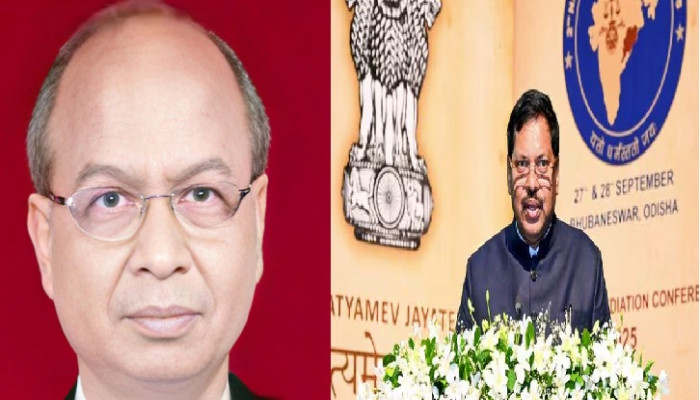Not the Slipper, Not the Sarcasm — But the Strength of Dharma
- In Current Affairs
- 12:20 PM, Oct 09, 2025
- V. Sai Bhargav
A slipper flung in rage and a jest uttered in arrogance — both reveal how far we have drifted from the discipline of Dharma.
In a land once guided by the Buddha’s compassion and the Vedic sanctity of vāk, even speech was sacred, for words could heal or destroy worlds.
The uproar in the Supreme Court over the Vishnu idol case is not merely a legal episode — it is a mirror held up to a civilisation forgetting how to speak with reverence.
In the Aṅguttara Nikāya, the Buddha once saw a monk scolding another in anger.
He waited patiently and then said, “If you plant a seed on stone, will it grow?”
The monk replied, “No, Lord, it cannot.”
The Buddha smiled and said, “So too, a word spoken in anger never bears good fruit. Speak only words that fall on fertile ground.”
This gentle story from the Tripitikas holds a timeless truth — speech, once uttered, becomes karma.
When words spoken from a seat of highest authority lose compassion and restraint, they fall not on fertile hearts but on stone — wounding the very faith of the people they are meant to guide.
So it was when Justice Gavai’s words, spoken in sarcasm about the devotees of Bhagwan Vishnu — reportedly asking devotees to seek answers from the deity Himself— struck a deep wound in the hearts of Hindus. What may have seemed a passing remark in court echoed far beyond its walls, reminding us that when reverence is met with mockery, it is not just faith that is bruised, but the nation’s moral conscience itself.
The Modern Courtroom and the Sacredness of Vāk
A recent uproar in the Supreme Court over remarks made in the Vishnu-idol case has reopened an ancient question: what is the moral discipline of speech for those who judge?
The Vedas call vāk — speech — Brahman’s breath.
The Ṛg Veda says, “Vāco vai Brahma — by speech, the worlds are sustained.”
For this reason, every Hindu, Buddhist, and Jain text insists that a judge or ruler must speak without hatred.
Ironically, the Dhamma itself offers the clearest guidance on such matters.
The Tripitikas emphasise Right Speech (Sammā Vācā) — one of the Noble Eightfold Path.
The Buddha advised:
“Speak only that which is true, kind, and beneficial. Let not your words cause harm to others.” (Aṅguttara Nikāya)
In that light, Justice Gavai’s sarcastic remark about the devotees of Vishnu seemed to stray from the Buddha’s own counsel.
It reflected not the compassion of the Tripitikas but the harsh tone often born of modern ideological bitterness.
When the heirs of the Dhamma forget its gentleness, even a word from the bench can wound more deeply than a verdict.
Imported Roots, Forgotten Foundations
India’s judiciary today rests on the twin pillars of British legal positivism and Enlightenment rationalism.
These gave us valuable structure, but severed law from Dharma.
Where ancient Nyāya sought truth through reasoned inquiry, colonial training taught procedure without conscience.
In replacing the ṛta of the Vedas — the cosmic order of truth — with rigid statutes, we built courts that know the law but forget the soul behind it.
Dr B. R. Ambedkar warned that political democracy cannot survive without moral democracy.
He looked not to Westminster, but to the Buddha’s Dhamma — to maitrī (friendship), karuṇā (compassion), and samyak vāc (right speech) — as the ethical roots of justice.
Sri Aurobindo, too, cautioned that India had borrowed the form of Western institutions “without inheriting the soul that should animate them.”
And Deen Dayal Upadhyaya reminded us that a system of law divorced from Dharma becomes “a weapon of adharma.”
The result today is a legal culture fluent in citation but poor in self-restraint, precise in argument but hollow in spirit.
To reform it, we need not reject modernity — we must re-anchor it in the civilisational soil of the Upaniṣads and Tripitikas, where justice was not fear of sanction but an act of sva-dharma — inner discipline guided by conscience.
The Wounds of Iconoclasm
History shows what happens when the guardians of Dharma forget their duty.
From the shattered Bamiyan Buddhas to the broken Vishnu idols of Khajuraho, India’s sacred art and learning have fallen before those who saw the divine image as blasphemy.
Their fury was not born of ignorance but of an exclusivist creed unable to accept another path to the divine.
Dr B. R. Ambedkar wrote bluntly in The Decline and Fall of Buddhism in India:
“The Musalman invaders sacked the monasteries, killed the monks, and burnt the books. This was the final blow to Buddhism in India.”
Ambedkar’s grief was not sectarian — it was civilisational.
When Nalanda and Vikramashila burned, it was not only stone and scripture that turned to ash, but the moral light of Asia itself.
Swami Vivekananda warned, “We allowed our temples to be broken because we forgot the spirit that built them. Strength — strength is what the Upanishads teach.”
And long before him, Swami Dayananda Saraswati declared in Satyarth Prakash:
“When men abandon the Vedas and neglect self-defence, the destroyers of Dharma rise and trample upon them.”
The lesson is clear — not vengeance, but vigilance.
Lessons from S. L. Bhyrappa and Kumārila Bhaṭṭa
Reading S. L. Bhyrappa’s Sārtha opened my eyes to that forgotten era of intellectual valour.
Through his pages, I met Kumārila Bhaṭṭa, the Mīmāṃsā scholar who entered Buddhist monasteries in disguise to master their philosophy and challenge it on equal ground.
When victory came, he felt remorse for his deceit and chose self-immolation as penance — purifying his act through truth.
His story carries two timeless lessons:
that Dharma must be defended not only with courage but with integrity,
and that the highest battle is not waged with weapons, but with śāstra — disciplined thought.
In a time when speech itself can wound a nation, Kumārila reminds us that conviction must always walk hand in hand with compassion.
The Middle Way Between Contempt and Violence
The recent conflict between an unguarded tongue and an angry protester reveals how far we have drifted from that discipline.
Neither derision from authority nor retaliation by force belongs to the Dharmic way.
As the Buddha said, “Like a bell struck in anger, the sound returns to the striker.”
Our tradition shows a higher path — the debating table of Kumārila Bhaṭṭa, the calm logic of Ādi Śaṅkara, the serene compassion of the Buddha.
There lies strength, not in iconoclasm, but in reasoned courage.
Reclaiming the Judicial Conscience
Reform must begin in the mind.
Law schools should teach not only statutes but Dharmaśāstra, Vinaya Pitaka, and Arthaśāstra, reminding future judges that justice is an act of service.
A judge guided by Dharma fears neither power nor popularity; he measures every word as offering.
When the judiciary rediscovers that moral vocabulary, corruption will fade naturally — for the one who sees law as sacred cannot sell it.
Conclusion
The task before us is not just to rebuild statues, but to rebuild the spirit that once guarded them — the culture of disciplined dialogue that made India unconquerable in mind and soul.
Legend tells of a Buddhist monk who stood helpless as invaders shattered the great Buddha of Bamiyan, whispering, “You can break the image, not the idea.”
Centuries earlier, as Nalanda burned, the guardians of Dharma watched their libraries turn to ash — the flames consuming not just books, but centuries of reason and reverence.
That fire has not died; it lies dormant within our civilisation.
Hatred still breathes — and when the time is right, it will bloom again, if we remain weak.
Our duty, then, is not mockery from the bench nor rage from the bar — not the loose tongue or the thrown slipper — but the awakening of strength, unity, and restraint.
As Swami Vivekananda said, “Strength, strength is what the Upanishads teach.”
Let us not repeat the silence of our ancestors; when Dharma stands awake within us, no power on earth can break it again.
Disclaimer: The opinions expressed within this article are the personal opinions of the author. MyIndMakers is not responsible for the accuracy, completeness, suitability, or validity of any information on this article. All information is provided on an as-is basis. The information, facts or opinions appearing in the article do not reflect the views of MyindMakers and it does not assume any responsibility or liability for the same.







Comments